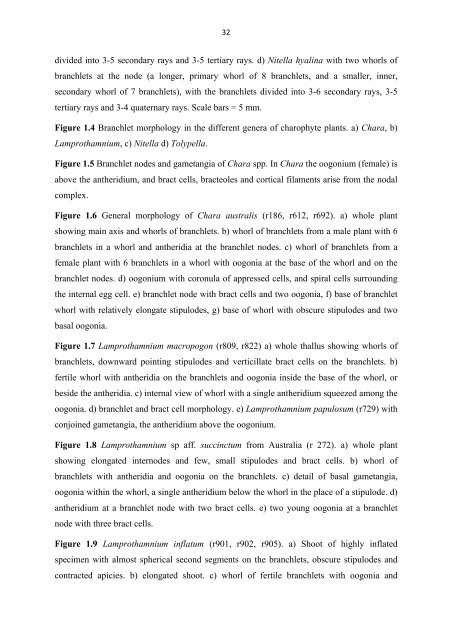Chapter 1: The Characeae Plant
Chapter 1: The Characeae Plant
Chapter 1: The Characeae Plant
You also want an ePaper? Increase the reach of your titles
YUMPU automatically turns print PDFs into web optimized ePapers that Google loves.
32 <br />
divided into 3-5 secondary rays and 3-5 tertiary rays. d) Nitella hyalina with two whorls of<br />
branchlets at the node (a longer, primary whorl of 8 branchlets, and a smaller, inner,<br />
secondary whorl of 7 branchlets), with the branchlets divided into 3-6 secondary rays, 3-5<br />
tertiary rays and 3-4 quaternary rays. Scale bars = 5 mm.<br />
Figure 1.4 Branchlet morphology in the different genera of charophyte plants. a) Chara, b)<br />
Lamprothamnium, c) Nitella d) Tolypella.<br />
Figure 1.5 Branchlet nodes and gametangia of Chara spp. In Chara the oogonium (female) is<br />
above the antheridium, and bract cells, bracteoles and cortical filaments arise from the nodal<br />
complex.<br />
Figure 1.6 General morphology of Chara australis (r186, r612, r692). a) whole plant<br />
showing main axis and whorls of branchlets. b) whorl of branchlets from a male plant with 6<br />
branchlets in a whorl and antheridia at the branchlet nodes. c) whorl of branchlets from a<br />
female plant with 6 branchlets in a whorl with oogonia at the base of the whorl and on the<br />
branchlet nodes. d) oogonium with coronula of appressed cells, and spiral cells surrounding<br />
the internal egg cell. e) branchlet node with bract cells and two oogonia, f) base of branchlet<br />
whorl with relatively elongate stipulodes, g) base of whorl with obscure stipulodes and two<br />
basal oogonia.<br />
Figure 1.7 Lamprothamnium macropogon (r809, r822) a) whole thallus showing whorls of<br />
branchlets, downward pointing stipulodes and verticillate bract cells on the branchlets. b)<br />
fertile whorl with antheridia on the branchlets and oogonia inside the base of the whorl, or<br />
beside the antheridia. c) internal view of whorl with a single antheridium squeezed among the<br />
oogonia. d) branchlet and bract cell morphology. e) Lamprothamnium papulosum (r729) with<br />
conjoined gametangia, the antheridium above the oogonium.<br />
Figure 1.8 Lamprothamnium sp aff. succinctum from Australia (r 272). a) whole plant<br />
showing elongated internodes and few, small stipulodes and bract cells. b) whorl of<br />
branchlets with antheridia and oogonia on the branchlets. c) detail of basal gametangia,<br />
oogonia within the whorl, a single antheridium below the whorl in the place of a stipulode. d)<br />
antheridium at a branchlet node with two bract cells. e) two young oogonia at a branchlet<br />
node with three bract cells.<br />
Figure 1.9 Lamprothamnium inflatum (r901, r902, r905). a) Shoot of highly inflated<br />
specimen with almost spherical second segments on the branchlets, obscure stipulodes and<br />
contracted apicies. b) elongated shoot. c) whorl of fertile branchlets with oogonia and
















